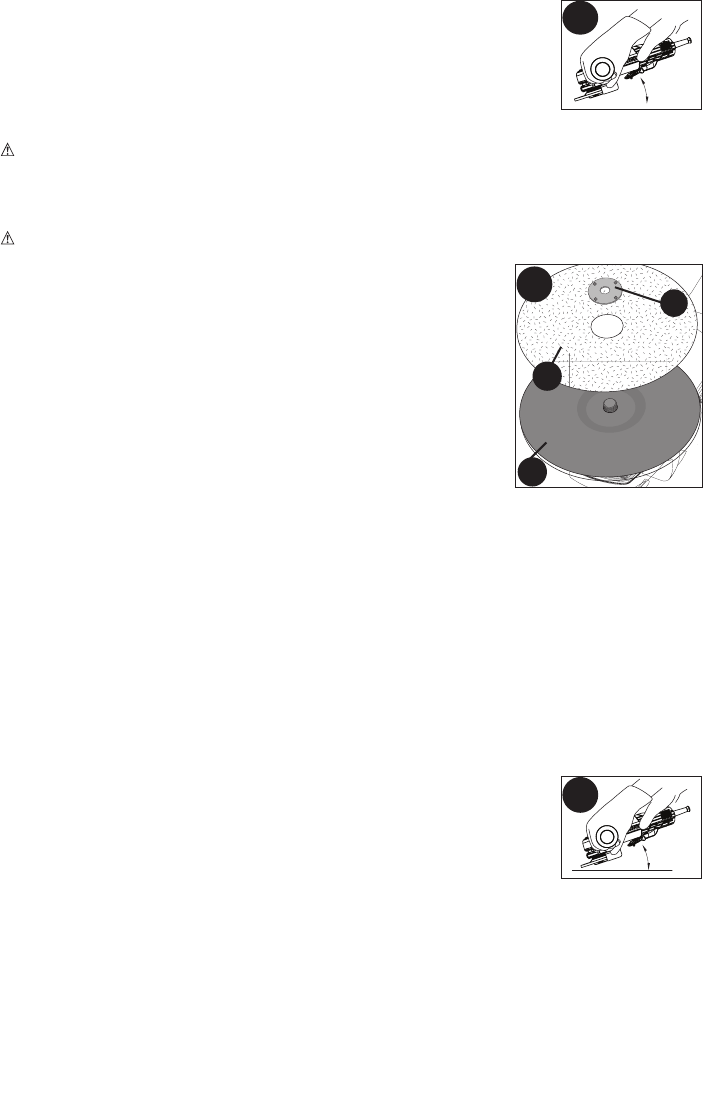
SURFACE FINISHING WITH SANDING FLAP DISCS
1. Allow the tool to reach full speed before touching the tool to the work surface.
2.Applyminimumpressuretoworksurface,allowingthetooltooperateathighspeed.
Sanding rate is greatest when the tool operates at high speed.
3.Figure K - Maintaina5˚to10˚anglebetweenthetoolandwork
surface.
4.Continuouslymovethetoolinaforwardandbackmotiontoavoid
creating gouges in the work surface.
5. Remove the tool from work surface before turning tool off. Allow
the tool to stop rotating before laying it down.
MOUNTING SANDING BACKING PADS
WARNING: To prevent accidental operation, turn off and unplug tool before
performing the following operations. Failure to do this could result in serious
personal injury.
NOTE: Guard may be removed when using sanding backing pads.
WARNING: Proper guard must be reinstalled for grinding wheel, sanding flap disc,
cutting wheel, wire brush or wire wheel applications after sanding
applications are complete.
1. Figure L - Placeorappropriatelythreadbackingpad(14)
on the spindle.
2.Placethesandingdisc(15)onthebackingpad(14).
3.Whiledepressingspindlelock,threadclampnut(13)on
spindle, piloting the raised hub on the clamp nut into the
center of san ding disc and backing pad.
4.Tightentheclampnutbyhand,thendepressthespindle
lock button while turning the sanding disc until the sanding
disc and clamp nut are snug.
5. To remove the wheel, grasp and turn the backing pad and
sanding pad while depressing the spindle lock button.
USING SANDING BACKING PADS
Choose the proper grit sanding discs for your application. Sanding discs are available in
various grits. Coarse grits yield faster material removal rates and a rougher finish. Finer
grits yield slower material removal and a smoother finish.
Beginwithcoarsegritdiscsforfast,roughmaterialremoval.Movetoamediumgrit
paper and finish with a fine grit disc for optimal finish.
Coarse 16-30grit
Medium 36-80grit
FineFinishing 100-120grit
Very Fine Finishing 150 - 180 grit
1. Allow the tool to reach full speed before touching tool to the work surface.
2.Applyminimumpressuretoworksurface,allowingthetooltooperateathighspeed.
Sanding rate is greatest when the tool operates at high speed.
3. Figure M - Maintaina5˚to15˚anglebetweenthetoolandwork
surface. The san ding disc should contact approximately one inch
(25mm)ofworksurface.
4.Movethetoolconstantlyinastraightlinetopreventburningand
swirling of work surface. Allowing the tool to rest on the work
surface without moving, or moving the tool in a circular motion
causes burning and swirling marks on the work surface.
5. Remove the tool from work surface before turning tool off. Allow the tool to stop
rotating before laying it down.
PRECAUTIONS TO TAKE WHEN SANDING PAINT
1.SandingofleadbasedpaintisNOTRECOMMENDEDduetothedifficultyof
controlling the contaminated dust. The greatest danger of lead poisoning is to children
and pregnant women.
2.Sinceitisdifficulttoidentifywhetherornotapaintcontainsleadwithoutachemical
analysis, we recommend the following precautions when sanding any paint:
1212
K
5˚-10˚
13
14
15
L
M
5˚-15˚


















